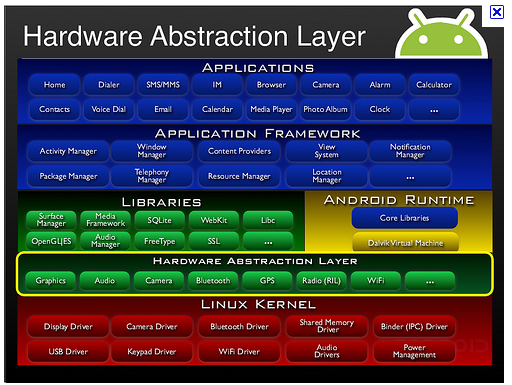Android中HAL如何向上層提供介面總結
參考文獻:
http://blog.csdn.net/luoshengyang/article/details/6573809
http://blog.csdn.net/hongtao_liu/article/details/6060734
建議閱讀本文時先瀏覽以上兩篇文章,本文是對上兩篇文章在HAL對上層介面話題的一個總結.
1 什麼是HAL
HAL的全稱是Hardware Abstraction Layer,即硬體抽象層.其架構圖如下:

Android的HAL是為了保護一些硬體提供商的智慧財產權而提出的,是為了避開linux的GPL束縛。思路是把控制硬體的動作都放到了Android HAL中,而linux driver僅僅完成一些簡單的資料互動作用,甚至把硬體暫存器空間直接對映到user space。而Android是基於Aparch的license,因此硬體廠商可以只提供二進位制程式碼,所以說Android只是一個開放的平臺,並不是一個開源的平臺。也許也正是因為Android不遵從GPL,所以Greg Kroah-Hartman才在2.6.33核心將Andorid驅動從linux中刪除。GPL和硬體廠商目前還是有著無法彌合的裂痕。Android想要把這個問題處理好也是不容易的。
總結下來,Android HAL存在的原因主要有:
1. 並不是所有的硬體裝置都有標準的linux kernel的介面
2. KERNEL DRIVER涉及到GPL的版權。某些裝置製造商並不原因公開硬體驅動,所以才去用HAL方式繞過GPL。
3. 針對某些硬體,Android有一些特殊的需求.
2 與介面相關的幾個結構體
首先來看三個與HAL對上層介面有關的幾個結構體:
struct hw_module_t; //模組型別
struct hw_module_methods_t; //模組方法
struct hw_device_t; //裝置型別3 解釋
一般來說,在寫HAL相關程式碼時都得包含這個hardware.h標頭檔案,所以有必要先了解一下這個標頭檔案中的內容.
/*
* Copyright (C) 2008 The Android Open Source Project
*
* Licensed under the Apache License, Version 2.0 (the "License");
* you may not use this file except in compliance with the License.
* You may obtain a copy of the License at
*
* http://www.apache.org/licenses/LICENSE-2.0
*
* Unless required by applicable law or agreed to in writing, software
* distributed under the License is distributed on an "AS IS" BASIS,
* WITHOUT WARRANTIES OR CONDITIONS OF ANY KIND, either express or implied.
* See the License for the specific language governing permissions and
* limitations under the License.
*/
#ifndef ANDROID_INCLUDE_HARDWARE_HARDWARE_H
#define ANDROID_INCLUDE_HARDWARE_HARDWARE_H
#include <stdint.h>
#include <sys/cdefs.h>
#include <cutils/native_handle.h>
#include <system/graphics.h>
__BEGIN_DECLS
/*
* Value for the hw_module_t.tag field
*/
#define MAKE_TAG_CONSTANT(A,B,C,D) (((A) << 24) | ((B) << 16) | ((C) << 8) | (D))
#define HARDWARE_MODULE_TAG MAKE_TAG_CONSTANT('H', 'W', 'M', 'T')
#define HARDWARE_DEVICE_TAG MAKE_TAG_CONSTANT('H', 'W', 'D', 'T')
struct hw_module_t;
struct hw_module_methods_t;
struct hw_device_t;
/**
* Every hardware module must have a data structure named HAL_MODULE_INFO_SYM
* and the fields of this data structure must begin with hw_module_t
* followed by module specific information.
*/
//每一個硬體模組都每必須有一個名為HAL_MODULE_INFO_SYM的資料結構變數,它的第一個成員的型別必須為hw_module_t
typedef struct hw_module_t {
/** tag must be initialized to HARDWARE_MODULE_TAG */
uint32_t tag;
/** major version number for the module */
uint16_t version_major;
/** minor version number of the module */
uint16_t version_minor;
/** Identifier of module */
const char *id;
/** Name of this module */
const char *name;
/** Author/owner/implementor of the module */
const char *author;
/** Modules methods */
//模組方法列表,指向hw_module_methods_t*
struct hw_module_methods_t* methods;
/** module's dso */
void* dso;
/** padding to 128 bytes, reserved for future use */
uint32_t reserved[32-7];
} hw_module_t;
typedef struct hw_module_methods_t { //硬體模組方法列表的定義,這裡只定義了一個open函式
/** Open a specific device */
int (*open)(const struct hw_module_t* module, const char* id, //注意這個open函式明確指出第三個引數的型別為struct hw_device_t**
struct hw_device_t** device);
} hw_module_methods_t;
/**
* Every device data structure must begin with hw_device_t
* followed by module specific public methods and attributes.
*/
//每一個裝置資料結構的第一個成員函式必須是hw_device_t型別,其次才是各個公共方法和屬性
typedef struct hw_device_t {
/** tag must be initialized to HARDWARE_DEVICE_TAG */
uint32_t tag;
/** version number for hw_device_t */
uint32_t version;
/** reference to the module this device belongs to */
struct hw_module_t* module;
/** padding reserved for future use */
uint32_t reserved[12];
/** Close this device */
int (*close)(struct hw_device_t* device);
} hw_device_t;
/**
* Name of the hal_module_info
*/
#define HAL_MODULE_INFO_SYM HMI
/**
* Name of the hal_module_info as a string
*/
#define HAL_MODULE_INFO_SYM_AS_STR "HMI"
/**
* Get the module info associated with a module by id.
*
* @return: 0 == success, <0 == error and *module == NULL
*/
int hw_get_module(const char *id, const struct hw_module_t **module);
/**
* Get the module info associated with a module instance by class 'class_id'
* and instance 'inst'.
*
* Some modules types necessitate multiple instances. For example audio supports
* multiple concurrent interfaces and thus 'audio' is the module class
* and 'primary' or 'a2dp' are module interfaces. This implies that the files
* providing these modules would be named audio.primary.<variant>.so and
* audio.a2dp.<variant>.so
*
* @return: 0 == success, <0 == error and *module == NULL
*/
int hw_get_module_by_class(const char *class_id, const char *inst,
const struct hw_module_t **module);
__END_DECLS
#endif /* ANDROID_INCLUDE_HARDWARE_HARDWARE_H */
由以上內容可以看出(typedef struct hw_module_t ,typedef struct hw_device_t),如果我們要寫一個自定義裝置的驅動的HAL層時,我們得首先自定義兩個資料結構:
假設我們要做的裝置名為XXX:
在標頭檔案中定義:XXX.h
/*定義模組ID*/
#define XXX_HARDWARE_MODULE_ID "XXX"
/*硬體模組結構體*/
//見hardware.h中的hw_module_t定義的說明,xxx_module_t的第一個成員必須是hw_module_t型別,其次才是模組的一此相關資訊,當然也可以不定義,
//這裡就沒有定義模組相關資訊
struct xxx_module_t {
struct hw_module_t common;
};
/*硬體介面結構體*/
//見hardware.h中的hw_device_t的說明,要求自定義xxx_device_t的第一個成員必須是hw_device_t型別,其次才是其它的一些介面資訊.
struct xxx_device_t {
struct hw_device_t common;
//以下成員是HAL對上層提供的介面或一些屬性
int fd;
int (*set_val)(struct xxx_device_t* dev, int val);
int (*get_val)(struct xxx_device_t* dev, int* val);
};接下來我們在實現檔案XXX.c檔案中定義一個xxx_module_t的變數:
/*模組例項變數*/
struct xxx_module_t HAL_MODULE_INFO_SYM = { //變數名必須為HAL_MODULE_INFO_SYM,這是強制要求的,你要寫Android的HAL就得遵循這個遊戲規則,
//見hardware.h中的hw_module_t的型別資訊說明.
common: {
tag: HARDWARE_MODULE_TAG,
version_major: 1,
version_minor: 0,
id: XXX_HARDWARE_MODULE_ID, //標頭檔案中有定義
name: MODULE_NAME,
author: MODULE_AUTHOR,
methods: &xxx_module_methods, //模組方法列表,在本地定義
}
};注意到上面有HAL_MODULE_INFO_SYM變數的成員common中包含一個函式列表xxx_module_methods,而這個成員函式列表是在本地自定義的。那麼這個成員函式列是不是就是HAL向上層提供函式的地方呢?很失望,不是在這裡,前面我們已經說過了,是在xxx_device_t中定義的,這個xxx_module_methods實際上只提供了一個open函式,就相當於只提供了一個模組初始化函式.其定義如下:
/*模組方法表*/
static struct hw_module_methods_t xxx_module_methods = {
open: xxx_device_open
};那麼HAL又到底是怎麼將xxx_device_t中定義的介面提供到上層去的呢?
且看上面這個函式列表中唯一的一個xxx_device_open的定義:
static int xxx_device_open(const struct hw_module_t* module, const char* name, struct hw_device_t** device) {
struct xxx_device_t* dev;
dev = (struct hello_device_t*)malloc(sizeof(struct xxx_device_t));//動態分配空間
if(!dev) {
LOGE("Hello Stub: failed to alloc space");
return -EFAULT;
}
memset(dev, 0, sizeof(struct xxx_device_t));
//對dev->common的內容賦值,
dev->common.tag = HARDWARE_DEVICE_TAG;
dev->common.version = 0;
dev->common.module = (hw_module_t*)module;
dev->common.close = xxx_device_close;
//對dev其它成員賦值
dev->set_val = xxx_set_val;
dev->get_val = xxx_get_val;
if((dev->fd = open(DEVICE_NAME, O_RDWR)) == -1) {
LOGE("Hello Stub: failed to open /dev/hello -- %s.", strerror(errno));
free(dev);
return -EFAULT;
}
//輸出&(dev->common),輸出的並不是dev,而是&(dev->common)!(common內不是隻包含了一個close介面嗎?)
*device = &(dev->common);
LOGI("Hello Stub: open /dev/hello successfully.");
return 0;
}在回答上述問題之前,讓我們先看一下這xxx_device_open函式原型,還是在hardware.h標頭檔案中,找到下面幾行程式碼:
typedef struct hw_module_methods_t {
/** Open a specific device */
int (*open)(const struct hw_module_t* module, const char* id,
struct hw_device_t** device);
} hw_module_methods_t;可是,dev->common不是隻包含close介面嗎?做為HAL的上層,它又是怎麼"看得到"HAL提供的全部介面的呢?
接下來,讓我們來看看做為HAL上層,它又是怎麼使用由HAL返回的dev->common的:
參考: 在Ubuntu為Android硬體抽象層(HAL)模組編寫JNI方法提供Java訪問硬體服務介面 這篇文章,從中可以看到這麼幾行程式碼:
/*通過硬體抽象層定義的硬體模組開啟介面開啟硬體裝置*/
static inline int hello_device_open(const hw_module_t* module, struct hello_device_t** device) {
return module->methods->open(module, HELLO_HARDWARE_MODULE_ID, (struct hw_device_t**)device);
} 此外,在hardware.h標頭檔案中,還有明確要求定義xxx_module_t型別時,明確要求第一個成員變數型別必須為hw_module_t,這也是為了方便找到其第一個成員變數common,進而找到本地定義的方法列表,從而呼叫open函式進行模組初始化.
綜上所述,HAL是通過structxxx_device_t這個結構體向上層提供介面的.
即:介面包含在structxxx_device_t這個結構體內。
而具體執行是通過struct xxx_module_t HAL_MODULE_INFO_SYM這個結構體變數的函式列表成員下的open函式來返回給上層的.
相關文章
- android HAL層程式碼Android
- Android Hal層簡要分析Android
- android音訊hal層簡介Android音訊
- Android HAL 層框架分析以及程式碼示例Android框架
- 硬體抽象層:HAL抽象
- Android Framework 音訊子系統(12)HAL層分析AndroidFramework音訊
- Android硬體抽象層(HAL)模組編寫規範Android抽象
- android藍芽hal層程式碼跟蹤記錄Android藍芽
- Android 11(R) Power HAL AIDL簡析 -- 基本介面AndroidAI
- Android中Service總結Android
- HAL 硬體抽象層介紹抽象
- 拋棄硬體抽象層 (HAL)抽象
- Android UI 之 Tab型別介面總結AndroidUI型別
- Android中的NDK總結Android
- 一個android 的HAL示例中遇到的坑。Android
- Android中活動間通訊總結Android
- iOS底層面試總結iOS面試
- android 介面佈局 很好的一篇總結 【轉】Android
- 免費介面總結
- 介面測試總結
- Android 6.0 中的新技術總結Android
- iOS底層原理總結 – RunLoopiOSOOP
- iOS底層原理總結 - RunLoopiOSOOP
- 【三層學習之總結】
- SQL Server中CTE的另一種遞迴方式-從底層向上遞迴SQLServer遞迴
- 總結!計網分層 每層任務 每層協議協議
- [譯] Android 中的 MVP:如何使 Presenter 層系統化?AndroidMVP
- 關於Android中各種尺寸的總結Android
- Android Audio HAL 介面介紹之 adev_set_parameters()和out_set_parameters()Androiddev
- 如何在程式碼層面提供CPU分支預測效率
- Android HAL模組的載入過程Android
- Android Thermal HAL 降龍十八掌Android
- android webview總結AndroidWebView
- Android面試總結Android面試
- Android 總結 bookAndroid
- Android總結1Android
- Android View總結AndroidView
- iOS底層GCD (技術總結)iOSGC